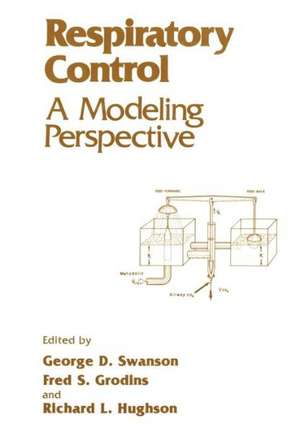Respiratory Control: A Modeling Perspective
Editat de F.S. Grodins, A. Shivarova, G.D. Swansonen Limba Engleză Paperback – 10 noi 2011
Preț: 652.81 lei
Preț vechi: 768.01 lei
-15% Nou
Puncte Express: 979
Preț estimativ în valută:
124.91€ • 136.11$ • 105.26£
124.91€ • 136.11$ • 105.26£
Carte tipărită la comandă
Livrare economică 23 aprilie-07 mai
Preluare comenzi: 021 569.72.76
Specificații
ISBN-13: 9781461278511
ISBN-10: 1461278511
Pagini: 484
Ilustrații: 460 p.
Dimensiuni: 170 x 244 x 25 mm
Greutate: 0.76 kg
Ediția:1989
Editura: Springer Us
Colecția Springer
Locul publicării:New York, NY, United States
ISBN-10: 1461278511
Pagini: 484
Ilustrații: 460 p.
Dimensiuni: 170 x 244 x 25 mm
Greutate: 0.76 kg
Ediția:1989
Editura: Springer Us
Colecția Springer
Locul publicării:New York, NY, United States
Public țintă
ResearchCuprins
Introductory Address: Oxford and Yale Physiologists in Colorado in 1911.- Respiratory Control and Gas Exchange Kinetics During Exercise.- Does Arterial Plasma Potassium Contribute to Exercise Hyperpnoea?.- Regulation of Alveolar Ventilation and Arterial Blood Gases During Exercise.- Evidence for Possible “Cardiogenic” Respiratory Drives in Exercising Man.- The Validity of the Cardiodynamic Hypothesis for Exercise Hyperpnea in Man.- Neurogenic and Cardiodynamic Drives in the Early Phase of Exercise Hyperpnea in Man.- The Effect of Exercise on The Central and Peripheral Chemoreceptor Thresholds to Carbon Dioxide in Man.- Modelling the Ventilatory Response to Pulses of Inhaled Carbon Dioxide in Exercise.- Control of Ventilation During Heavy Exercise in Man.- Estimating Arterial PCO2 From Flow-Weighted and Time-Average Alveolar PCO2 During Exercise.- The Effect of Exercise Intensity on the Linearity of Ventilatory and Gas Exchange Responses to Exercise.- Interrelation of Respiratory Responses to VCO2 Pedal Rate and Loading Force During Cycle Exercise.- On Smoothing Gas Exchange Data and Estimation of the Ventilatory Threshold.- Kinetics of Oxygen Uptake Studied with Two Different Pseudorandom Binary Sequences.- Gas Exchange Inferences for the Proportionality of the Cardiopulmonary Responses During Phase I of Exercise.- On Modelling Alveolar Oxygen Uptake Kinetics.- A General-Purpose Model for Investigating Dynamic Cardiopulmonary Responses During Exercise.- Lactate Balance During Low Levels of Exercise.- Oxygen Kinetics in the Elderly.- Breath-by-breath Gas Exchange: Data Collection and Analysis.- Respiratory Control During Altered Gas Mixtures.- Increased Arterial Potassium Levels May Contribute to the Drive to Breathe at Very High Altitude.- Hypoxia > 25 Years AfterCarotid Body Resection Causes More Tachycardia Although Less Hyperventilation Than in Controls.- The Transients in Ventilation Arising from a Period of Hypoxia at Near Normal and Raised Levels of End-Tidal CO2 in Man.- Asymmetry in the Ventilatory Response to a Bout of Hypoxia in Human Beings.- Studies on Exercise Hyperpnea in Relation with Hypoxic Ventilatory Chemosensitivity Measured at Rest.- Dynamics of the Ventilatory Controller and Hypoxic Stimulation in Man.- Building Dynamic Models of the Control of Breathing During Hypoxia.- Evidence in Man to Suggest Interaction Between the Peripheral and Central Chemoreceptors.- Modelling the Dynamic Ventilatory Response to Carbon Dioxide in Healthy Human Subjects During Normoxia.- Dynamics of the Peripheral Chemoreflex Loop Following Acute Acid-Base Disturbances in Cats.- 3-D Theory of Respiration: The Steady-State Case.- Inhaled CO2 as a Constant Fraction in Inspired Air and as Early-Inspired Pulses.- Breathing Patterns and Neural Factors.- Adaptive Multivariate Autoregressive Modelling of Respiratory Cycle Variables.- Factors Inducing Periodic Breathing in Man During Acclimatization to Chronic Hypoxia.- A Model of Respiratory Variability During Non-Rem Sleep.- The Use of Deep Non-Rem Sleep to Study the Pattern of Breathing in the Absence of Any Forebrain Influences.- Modelling the Breath by Breath Variability in Respiratory Data.- Is the Respiratory Rhythm Multistable in Man?.- Ventilatory Responses to Short Carotid Sinus Pressure Stimuli: Interpretation Using a Model of Rhythm Generation.- Comparison of Unification Techniques for Inconstant Intervals of Breath-by-Breath Sequence.- Phase Resetting of Respiratory Rhythm Studied in a Model of a Limit-Cycle Oscillator: Influence of Stochastic Processes.- Intracycle Relationship Between Successive Phases of the Respiration: A New Modelling Assumption.- Is Respiratory Period Spectrum Characteristic of State, Individual, Sex and Species?.- Isopnoeic Analyses of Human Steady-State Flow Profiles.- In Favour of an “Holistic” Approach to the Analysis of the Pattern of Breathing.- Vagal Control on Exercise-Induced Hyperpnea in Conscious Dogs.- Expiratory Activity Recorded During Exercise from Human M. Biceps Brachii Reinnervated by Internal Intercostal Nerves.- Recruitment and Frequency Coding of Diaphragm Motor Units during Ventilatory and Non-Ventilatory Behaviors.- Supraspinal Descending Control of Propriospinal Respiratory Neurons in the Cat.







